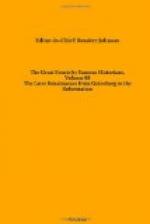On his return to Rome in 1508, Michelangelo had found Julius II not cooled toward him, but preoccupied by new projects. The Pope made no allusion to his monument, and was absorbed in the reconstruction of St. Peter’s, which he had confided to Bramante. Raphael was beginning at the same time the frescoes of the Stanza della Segnatura; and two biographers of Michelangelo, whose testimony, it is true, on this point may be suspected, agree in saying that the architect of St. Peter’s, jealous of the superiority of the Florentine sculptor, fearing lest he should discover the mistakes committed in his recent constructions, and the malversations of which perhaps he was not innocent, advised the Pope to confide to him the painting of the ceiling of the chapel built by Sixtus IV, hoping to compromise and ruin him by engaging him in works of which he had no experience.
Julius adopted the idea, sent for Michelangelo, and ordered him to begin forthwith. Buonarroti had had no practice in fresco-painting since his student days under Ghirlandajo. He knew that the painting of a ceiling was not an easy matter. He pleaded every excuse, proposed that the commission should be given to Raphael, saying that for his part, being but a sculptor, he could not succeed. The Pope was inflexible, and Michelangelo began the ceiling on May 10, 1508, the most prodigious monument perhaps that ever sprang from the human mind.
Julius had ordered Bramante to construct the necessary scaffoldings, but the latter did it in so inefficient a manner that Michelangelo was obliged to dispense with his assistance, and construct the whole machinery himself. He had sent for some of his fellow-students from Florence, not, as Vasari, by some strange aberration, states, because he was ignorant of fresco-painting, since all the artists of the time understood it, and the pupil of Ghirlandajo had himself practised it, but because his fellow-students had had more experience in it, and he wished to be helped in a work of this importance. He was, however, so dissatisfied with their work that he effaced all that they did, and, without any assistance, if we are to believe his biographer, even grinding his own colors, he shut himself up in the chapel, beginning at dawn, quitting at nightfall, often sleeping in his clothes on the scaffolding, allowing himself but a slight repast at the end of the day, and letting no one see the works he had begun.




